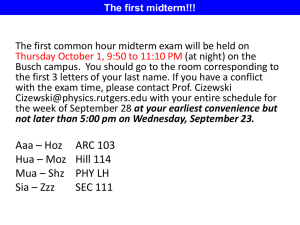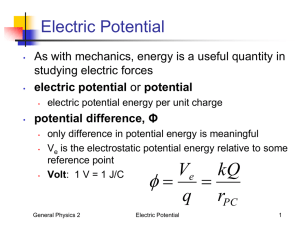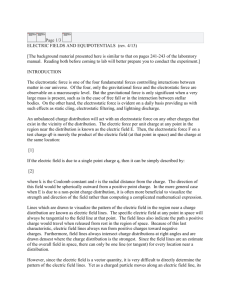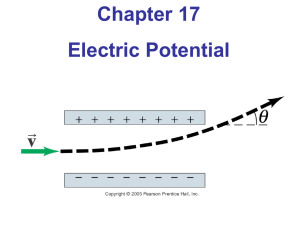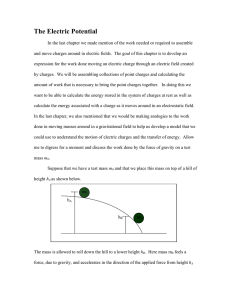The Electric Potential Difference
advertisement
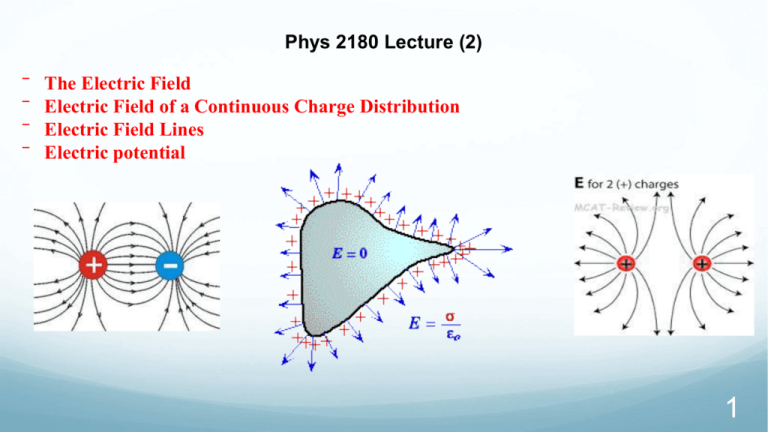
Phys 2180 Lecture (2) ‾ ‾ ‾ ‾ The Electric Field Electric Field of a Continuous Charge Distribution Electric Field Lines Electric potential 1 18.6 The Electric Field As we know, a charge can experience an electrostatic force due to the presence of other charges. This surrounding Force/Coulomb is known as the Electric Field DEFINITION OF ELECRIC FIELD The electric field that exists at a point is the electrostatic force experienced by a small test charge placed at that point divided by the charge itself: F E qo SI Units of Electric Field: newton per coulomb (N/C) 2 18.6 The Electric Field Example 6 A Test Charge The positive test charge has a magnitude of 3.0x10-8C and experiences a force of 6.0x10-8N. (a) Find the electric field (force per coulomb) that the test charge experiences. (b) Predict the force that a charge of +12x10-8C would experience if it replaced the test charge. (a) (b) F 6.0 10 8 N 2.0 N C 8 qo 3.0 10 C F 2.0 N C 12.0 108 C 24 108 N 3 18.6 The Electric Field It is the surrounding charges that create the electric field at a given point. The electrostatic force points in the direction of attraction The electric field always points away from the positive charge and towards the negative charge. 4 18.6 The Electric Field Example 7 An Electric Field Leads to a Force The charges on the two metal spheres and the ebonite rod create an electric field at the spot indicated. The field has a magnitude of 2.0 N/C. Determine the force on the charges in (a) and (b) 5 18.6 The Electric Field (a) F qo E 2.0 N C 18.0 108 C 36 108 N (b) F qo E 2.0 N C 24.0 108 C 48 108 N 6 18.6 The Electric Field Example 10 The Electric Field of a Point Charge The isolated point charge of q=+15μC is in a vacuum. The test charge is 0.20m to the right and has a charge qo=+0.80μC. Determine the electric field at point P. F E qo F k q1 q2 r2 7 18.6 The Electric Field F k q qo r2 8.99 10 9 N m 2 C 2 15 10 6 C 0.80 10 6 C 0.20m 2 2.7 N F 2.7 N 6 E 3 . 4 10 NC qo 0.80 10-6 C q qo 1 F E k 2 qo r qo The electric field does not depend on the test charge. Point charge q: Ek q r2 8 7) Electric Field Lines (lines of force) a) Direction of force on positive charge radial for point charges out for positive (begin) in for negative (end) 9 b) Number of lines proportional to charge Q 2Q c) Begin and end only on charges; never cross E? 10 d) Line density proportional to field strength Line density at radius r: N 1 2 2 4r r Number of lines area of sphere Lines of force model <==> inverse-square law 11 Electric Field Lines Electric field lines always begin on a positive charge and end on a negative charge and do not stop in Mid-space. 12 18.7 Electric Field Lines of two identical charges (dipoles) The number of lines leaving a positive charge or entering a negative charge is proportional to the magnitude of the charge. 13 18.7 Electric Field Lines of two different charges 14 Demonstration: Van de Graff generator - purpose: to produce high field by concentrating charge -- used to accelerate particles for physics experts - principle: charge on conductors moves to the surface 15 Electric Potential Energy is conservative Gravitational force Electrostatic force Note: Electric energy is one type of energy. 16 Reference Point of Electric Potential Energy The reference point can be anywhere. For convenience, we usually set charged particles to be infinitely separated from one another to be zero potential energy The potential energy U of the system at any point f is where W∞ is the work done by the electric field on a charged particle as that particle moves in from infinity to point f. 17 Electric Potential The electric potential difference V at a given point is the electric potential energy U of a small test charge q0 situated at that point divided by the charge itself: If we set at infinity as our reference potential energy, SI Unit of Electric Potential: joule/coulomb=volt (V) Note: •Both the electric potential energy U and the electric potential V are scalars. •The electric potential energy U and the electric potential V are not the same. The electric potential energy is associated with a test charge, while electric potential is the property of the electric field and does not depend on the test charge. 18 The Electric Potential Difference The electric potential difference between any two points i and f in an electric field. • It is equal to the difference in potential energy per unit charge between the two points. • the negative work done by the electric field on a unite charge as that particle moves in from point i to point f. Note: •Only the differences ΔV and ΔU are measurable in terms of the work W. •The is ΔV property of the electric field and has nothing to do with a test charge •The common name for electric potential difference is "voltage". 19 Notes Continue • Electric field always points from higher electric potential to lower electric potential. • A positive charge accelerates from a region of higher electric potential energy (or higher potential) toward a region of lower electric potential energy (or lower potential). • A negative charge accelerates from a region of lower potential toward a region of higher potential. 20 24.3 Electric Potential: The potential energy per unit charge at a point in an electric field is called the electric potential V (or simply the potential) at that point. This is a scalar quantity. Thus, If we set Ui =0 at infinity as our reference potential energy, then the electric potential V must also be zero there. Therefore, the electric potential at any point in an electric field can be defined to be Here W∞ is the work done by the electric field on a charged particle as that particle moves in from infinity to point f. The SI unit for potential is the joule per coulomb. This combination is called the volt (abbreviated V). 21 Problem 22 23 Example 2 Work, Electric Potential Energy, and Electric Potential The work done by the electric force as the test charge (q0=+2.0×10–6 C) moves from A to B is WAB=+5.0×10–5 J. (a) Find the difference, ΔU=UB–UA, in the electric potential energies of the charge between these points. (b) Determine the potential difference, ΔV=VB–VA, between the points. W V VA VB q 5 10 5 J 2 10 6 25 V U V VA VB q U qV 25V (2 10 6 C ) 5 10 5 J 24 Example 4 Electric Field and Electric Potential Two identical point charges (+2.4×10–9 C) are fixed in place, separated by 0.50 m. Find the electric field and the electric potential at the midpoint of the line between the charges qA and qB. F E , q E k FAB k q A qB r2 qA r2 8.99 109 N m 2 C 2 2.4 10 9 C 345.22 N 2 0.50 / 2m V VA VB Ed 0.5 2 86.304 V 345.22 25 Electric Potential 2.1 Electrostatic Potential Energy and Potential Difference The electrostatic force is conservative – potential energy can be defined Change in electric potential energy is negative of work done by electric force: Electric potential is defined as potential energy per unit charge: Unit of electric potential: the volt (V). 1 V = 1 J/C. 2.1 Electrostatic Potential Energy and Potential Difference Electrical sources such as batteries and generators supply a constant potential difference. Here are some typical potential differences, both natural and manufactured: 2.2 Equipotential Surfaces An equipotential is a line or surface over which the potential is constant. Electric field lines are perpendicular to equipotentials. The surface of a conductor is an equipotential. 2.2 Equipotential Surfaces Example 23-10: Point charge equipotential surfaces. For a single point charge with Q = 4.0 × 10-9C, sketch the equipotential surfaces (or lines in a plane containing the charge) corresponding to V1 = 10V, V2 = 20V, and V3 = 30V. 2.2 Equipotential Surfaces Equipotential surfaces are always perpendicular to field lines; they are always closed surfaces (unlike field lines, which begin and end on charges).

